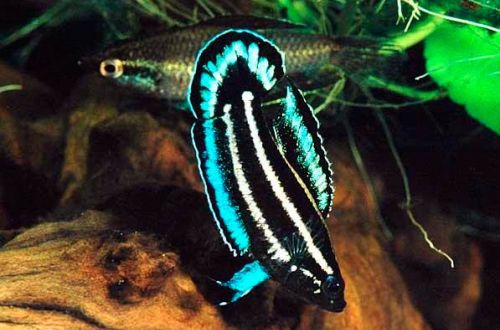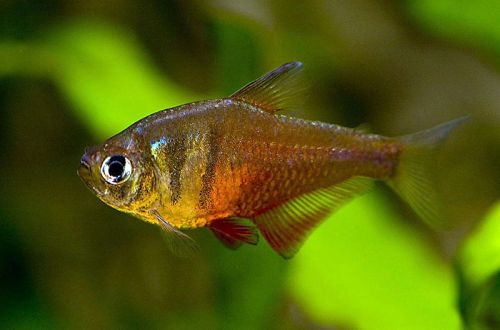
Parosfromenus Harvey
Parosfromenus Harvey or Kupanus Harvey, scientific name Parosphromenus harveyi, belongs to the Osphronemidae family. Named after explorer Willie Harvey. Not the most popular species in the aquarium trade, due to the difficulty of keeping and extremely limited export from habitats.

Contents
Habitat
It comes from Southeast Asia from the peninsular part of Malaysia. The natural habitat roughly coincides with the territory of the state of Selangor. Inhabits peat bogs located in the depths of tropical forests. A typical biotope is a shaded pond with dense coastal vegetation and very dark water, the bottom of which is covered with a thick layer of fallen leaves, branches, grass and other material. A similar color is given by high concentrations of humic acids and other tannins released as a result of the decomposition of plant organic matter.
The province of Selangor is one of the most densely populated in Malaysia. Active human economic activity has led to deforestation and pollution of the remaining water bodies, which has affected the number of wild populations of these fish. They are currently on the verge of extinction.
Brief information:
- The volume of the aquarium – from 30 liters.
- Temperature – 22-28°C
- Value pH — 3.0–6.5
- Water hardness – 1–5 dGH
- Substrate type – any dark
- Lighting – subdued
- Brackish water – no
- Water movement – little or no
- The size of the fish is about 3 cm.
- Food – live or frozen food
- Temperament – peaceful
- Content – in a group of relatives or with other small species
Description
Adult individuals reach a length of about 3 cm. The body pattern consists of alternating horizontal dark and light stripes. In males, the fins and tail have a black stripe bordered on both sides with turquoise stripes, and the inner one is much thicker. With the onset of the mating season, the intensity of the flowers intensifies. Females do not look as bright, do not have blue stripes on the fins, and the main body color in sexually mature individuals is pale yellow.
Food
Carnivorous look. In nature, it feeds on small aquatic insects, larvae and other invertebrates. In a home aquarium, it is desirable to serve live or frozen foods such as brine shrimp, daphnia, bloodworms, mosquito larvae, fruit flies, etc.
Maintenance and care, arrangement of the aquarium
The optimal size of the aquarium for one pair of fish starts from 20-30 liters. The most harmonious Parosfromenus Harvey will look in conditions resembling a natural habitat. The design should provide places for shelters, for example, driftwood with thickets of plants or artificial decor, stylized in a similar way. Dark soil on which a layer of dried leaves of some trees is placed. The lighting is subdued, or shading is created by floating plants. However, customization is allowed. Many breeders do not use a substrate at all for ease of maintenance, but use fragments of PVC pipes, ceramic pots turned on their side, and other hollow vessels / containers as shelter.
The hardest part about keeping this species is maintaining very low pH and dGH values. It may be necessary to install a reverse osmosis system or use another method to obtain soft acidic water. Filtration should not be too strong to avoid excessive internal flow. Sometimes a simple airlift filter with a sponge is enough.
The biological balance of the aquarium will depend on the smooth operation of the equipment and the regularity of maintenance procedures: removal of waste (food residues, excrement), replacement of part of the water (5–10% of the volume) with fresh water.
Behavior and Compatibility
Males compete with each other for the attention of females. Their competition intensifies during the spawning season, however, in most cases, everything ends with a “show of strength”. It is advisable to keep in pairs or groups. Given the modest size of Harvey’s Kupanus, when choosing neighbors, you should limit yourself to the same small fish from among the barbs, parsing, etc.
Breeding / breeding
In a favorable environment, spawning is not uncommon. With the onset of the breeding season, males occupy a site at the bottom of the aquarium in the center of which there is a shelter in the form of a cave or just a secluded place among snags and thickets of plants. Sometimes a nest of air bubbles is built inside the shelter. Having decided on the place, the male proceeds to courtship. When one of the females agrees, the spawning process begins, accompanied by a kind of “dancing” when the male coils around the body of the female. During the embrace, a portion of caviar appears and is immediately fertilized. Each egg is carefully placed inside the shelter. Males usually swim away, and the male remains to guard the clutch. The incubation period lasts 24-36 hours. A week later, the fry begin to swim freely. In the absence of other fish species nearby, juveniles can grow with their parents without fear of being eaten. Otherwise, they should be transplanted into a separate aquarium.
Fish diseases
A well-established biological system, a balanced diet and the absence of stressful situations (for example, being chased by aggressive fish) are the best guarantee of maintaining health. When the first signs of an illness appear, first of all, attention should be paid to these three factors, perhaps there was a deviation in one of them. As a rule, solving the problem leads to self-healing. However, if the immune system fails, you will have to resort to medical treatment. Read more about symptoms and treatments in the Aquarium Fish Diseases section.





